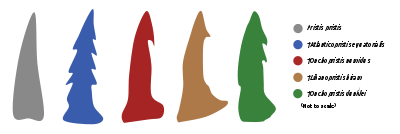Onchopristis
Onchopristis is a genus of extinct giant sclerorhynchid (a sawfish-like chondrichthyan) from the Lower Cretaceous to Upper Cretaceous of North America, North Africa, Brazil, and New Zealand. It had an elongated snout lined laterally with barbed "teeth", or denticles.[2][3]
| Onchopristis | |
|---|---|
| Tooth of O. numidus from the Tegana Formation, of the Kem Kem Beds | |
| Scientific classification | |
| Kingdom: | Animalia |
| Phylum: | Chordata |
| Class: | Chondrichthyes |
| Order: | †Sclerorhynchiformes |
| Suborder: | †Sclerorhynchoidei |
| Family: | †Sclerorhynchidae |
| Genus: | †Onchopristis Stromer, 1917[1] |
| Type species | |
| †Gigantichthys numidus Haug, 1905 | |
| Species | |
| |
| Synonyms[2] | |
| |
Description
_and_Onchopristis.jpg)
The rostrum, or snout, was around 1–2 metres (3.3–6.6 feet) long,[4] lined with barbed "teeth" or denticles. In the type species, O. numidus, each tooth had one barb, but in O. dunklei there were two to five barbs on each tooth, and two to three in O. d. praecursor.[2] This sclerorynchid was about 5–6 metres (16.4–19.7 feet) long.[4]

Paleobiology
As with modern sawfish, Onchopristis's eyes were on top of its head, to spot predators rather than prey, and its mouth and gills were under its body. The rostrum most likely would have had electroreceptors to detect food in the water below them like most modern sharks and some rays. Onchopristis may have raked through the riverbed to find and then eat prey.[5]
References
- Stromer, E. (1917). "Ergebnisse der Forschungsreisen Prof. E. Stromers in den Wüsten Ägyptens: Wirbeltier-Reste der Baharije-Stufe (unterstes Cenoman)". Abhandlungen der Königlich Bayerischen Akademie der Wissenschaften, Math.-naturwiss. Abt., N.F. 28 (8): 1–28.
|chapter=ignored (help) - Keyes, I.W. (1977). "Records of the northern hemisphere Cretaceous Sawfish genus Onchopristis (order batoidea) from New Zealand". New Zealand Journal of Geology and Geophysics. 20 (2): 263–272. doi:10.1080/00288306.1977.10420706.
- Medeiros, Manuel Alfredo; Lindoso, Rafael Matos; Mendes, Ighor Dienes; Carvalho, Ismar de Souza (2014-08-01). "The Cretaceous (Cenomanian) continental record of the Laje do Coringa flagstone (Alcântara Formation), northeastern South America". Journal of South American Earth Sciences. 53: 50–58. doi:10.1016/j.jsames.2014.04.002. ISSN 0895-9811.
- This huge ancient sawfish had harpoons on its face
- Scott, C. (2012). Planet Dinosaur: The Next Generation of Killer Giants. Firefly Books. pp. 72–73. ISBN 978-1-77085-049-1.
- Dutheil, D.B., Brito, P.M., 2009. Articulated cranium of Onchopristis numidus (Sclerorhynchidae, Elasmobranchii) from the Kem Kem Beds, Morocco. In: Jalil, N.-E. (Ed.), 1st International Congress on North African Vertebrate Palaeontology, Program & Abstracts, Marrakech, 25–27 May 2009, p. 66.
- Haug, E. Paléontologie. Documents Scientifiques de la mission saharienne (mission Foureau-Lamy). Publications de la Société de Géographie, p. 751-832